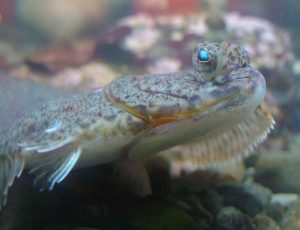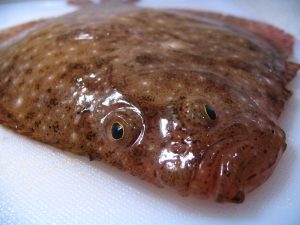Maine Seafood Guide – Flounder

Season
Status
Regulatory Authority
Harvest Method
Recreational Harvest
Health Benefits & Risks
Buying & Preparing
Brands
Certifications
Links
►Species Description
American plaice (or dab) Hippoglossoides platessoides
Winter flounder (blackback flounder or lemon sole) Pseudopleuronectes americanus
Windowpane (sand) flounder Scophthalmus aquosus
Witch flounder (grey sole) Glyptocephalus cynoglossus
Yellowtail flounder Limanda ferruginea

Wild.
Flounders are flat fishes: they lie not on their bellies, but on one side. Their skulls twist as they grow, so that the eye that was originally on the underside migrates around the head, until both eyes come to lie close together on the side facing up, either left or right.
American plaice or dab is a large-mouthed, right-eyed flounder common in deep, sandy or muddy-bottomed waters in the Gulf of Maine and along the Northwest Atlantic continental shelf from southern Labrador to Rhode Island.
Winter flounder is a thick, right-eyed flatfish with dark mottled skin, inhabiting the shallow, muddy bottoms of brackish rivers and estuaries from Labrador to Georgia.
Windowpane flounder is a thin, pale, left-eyed flatfish that lives on the bottom of sandy and muddy bays and estuaries from the Gulf of St. Lawrence to Florida, with concentrations on Georges Bank and the mid-Atlantic. In the Gulf of Maine, most are found in Massachusetts Bay.
Witch flounder is a thin, smooth, right-eyed flatfish found from Labrador to Virginia in deep, muddy-bottomed waters. Generally brown or russet gray.
Yellowtail flounder is a thin, right-eyed flatfish ranging deep, sandy-bottom habitat from Gulf of St. Lawrence to Chesapeake Bay.
►Season
Plaice: Year-round, with peak in spring and summer.
Winter flounder: Spring through fall.
Windowpane flounder: Illegal to harvest.
Witch flounder: Year-round.
Yellowtail: Late fall through spring.
►Status

American plaice stock is not overfished nor is overfishing occurring.
A 2015 stock assessment on Winter flounder could not estimate abundance, but did determine that overfishing is not occurring.
Windowpane flounder is illegal to harvest.
Witch flounder is overfished and overfishing is occurring.
Yellowtail flounder is overfished and overfishing is occurring.
►Regulatory Authority
Flounder and plaice are part of the Northeast Multispecies (groundfish) fishery managed by the New England Fishery Management Council. Winter flounder is co-managed with the Atlantic States Marine Fisheries Commission.
►Harvest Method
Flatfishes are generally caught by otter trawl and gillnet, also some by hook and line.
►Recreational Harvest
Minimum sizes:
- winter flounder: 12 inches
- witch flounder: 14 inches
- yellowtail: 13 inches
- summer flounder: 20 inches
Bag limit: two summer flounder per day and eight winter flounder per day.
Season: Maine anglers can fish for flounder year-round.
Note: Windowpane flounder are illegal to harvest.
►Health Benefits & Risks
Flounder is a low-fat, low-calorie source of vitamin B12, vitamin D, selenium, and omega-3 fatty acids. Flounder is low in mercury. Windowpane flounder is sensitive to pollution, and in general the presence of healthy flatfishes indicates clean water and sediment.
►Buying & Preparing
Flounder is a delicate, flaky white fish, best for frying, broiling, baking, and poaching. Ask the fishmonger for flounder species if it is not indicated.
►Companies, Brands, and Labels
►Certifications & Verifications
►Links
- NOAA Fisheries Species Directory
